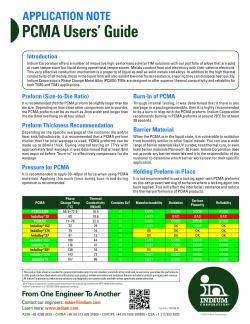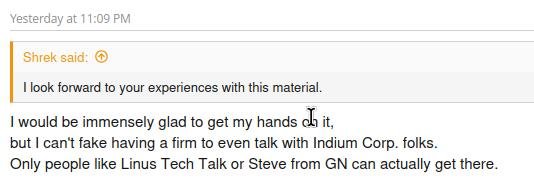1)Liquid Metal fully melts the aluminum;
Those two don't belong in the same sentence anyway. Why would anyone use the lowest-end heatsink with a highest-end thermal interface? Rhetorical Q.
2)Liquid Metal oxidize, so for this reason you need to reapply it every 6 months;
That would make it worse longevity related than the average silicon oil-based paste, which is simply not true.
3)Liquid Metal amalgamates with naked copper,so If your heat sink is not nickel plated, but even if it is - it will amalgamate anyway, but more slowly.
This amalgamation is dangerous, because it grows tiny microscopic crystals which can hurt the silicon die surface underneath of your heat spreader.
Copper absorbs gallium up to a point (effectively plating copper with gallium permanently), and it just leave stains, without compromising its structure and performance in any way.
Yes corrosion may happen with a low quality nickel-plated heatsinks. Yes it stains copper heatsinks. Yes it needs a careful handling during, and extra steps (isolating SMDs) before application (also probably one re-application after the initial one if used with copper, due to the gallium migration into it, but it depends on the amount initially applied obviously).
But it's still the best performing TIM by far. Only PTM coming close to it, but mostly because of the convenience, and not the outstanding performance nor superb longevity (compared to the LM apparently).
The biggest problem I find when thinking about purchasing the PTM is how to get the authentic stuff, when there are so many fake/low quality products around (yes I read about PTM pumping out the same way the regular silicon oil paste does, which is insane, and yes I'm talking about the GPU bare die application from the beggining of this post).
That's why sourcing, and living with the TG LM is much more convenient than testing a dozen of a questionable quality PTM variants. I don't have the money, nerves nor time for that anymore.
I'm not jumping your thread for downplaying it, but just to state some things which people throw around like facts when talking about LM, which are simply not true.
There are some LM horror stories told by the experienced users, but most of them are told by the inexperienced ones, further dissuading others from even trying it, and I'm OK with that honestly.
LM is not suitable to use between every heatsink-heatspreader/bare die, just as it's not suitable to be used by anyone. And it should stay that way.
And good luck with testing that PCM LM. I'm looking forward to the results.



 )
)



